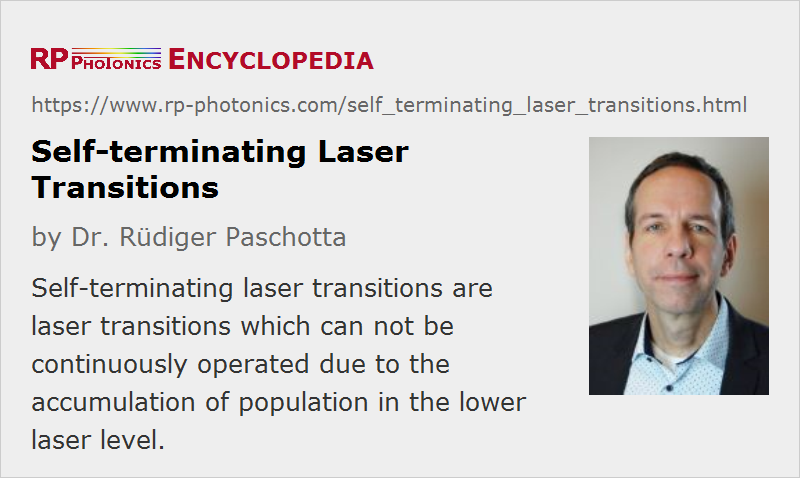Self-terminating Laser Transitions
Definition: laser transitions which can not be continuously operated due to the accumulation of population in the lower laser level
More general term: laser transitions
Category:  laser devices and laser physics
laser devices and laser physics
Author: Dr. Rüdiger Paschotta
Cite the article using its DOI: https://doi.org/10.61835/65a
Get citation code: Endnote (RIS) BibTex plain textHTML
Some solid-state gain media have laser transitions where the lower laser level is metastable and has a long lifetime – even longer than the upper-state lifetime. An example of this situation is the 2.7-μm transition (4I11/2 → 4I13/2) of erbium (Er3+) in fluoride fibers. Here, neither multi-phonon transitions nor the pump radiation can depopulate the lower laser level. In that case, the laser transition is usually self-terminating: lasing is possible only for a short while, until the lower level is so strongly populated that a population inversion is no longer possible. After that, the gain medium requires some time without pumping, until lasing can be restarted. Therefore, such lasers are often suitable only for pulsed operation, unless additional measures are taken to depopulate the lower laser level (see below). That limitation of such lasers has also led to the term transient laser.
Another examples of self-terminating lasers are the copper vapor laser, as described in the article on metal vapor lasers, and nitrogen lasers.
Achieving Continuous Laser Operation
For achieving continuous-wave operation of a laser with a self-terminating transition, one needs to implement a sufficiently effective process for depopulating the lower laser level. Several techniques with that purpose have been implemented; some examples:
- One may introduce an additional dopant which can quench the population in the lower laser level by means of an energy transfer. In the above-mentioned case of the 2.7-μm erbium laser [2, 3], and similarly for holmium-doped lasers [4], praseodymium (Pr3+) codoping has proven to be a good solution.
- An alternative, but less successful solution is to use a high erbium doping concentration [1]. This introduces various cross-relaxation processes, which can depopulate the lower laser level but also affect the upper-state population.
- Also, it is sometimes possible to arrange for cooperative lasing from the lower laser level to a still lower energy level.
More to Learn
Encyclopedia articles:
Bibliography
| [1] | E. Poppe et al., “980 nm diode-pumped continuous wave mid-IR (2.7 μm) fiber laser”, Electron. Lett. 34, 2331 (1998); https://doi.org/10.1049/el:19981582 |
| [2] | B. Srinivasan et al., “High-power 'watt-level' CW operation of diode-pumped 2.7 μm fiber lasers using efficient cross-relaxation and energy transfer mechanisms”, Opt. Express 4 (12), 490 (1999); https://doi.org/10.1364/OE.4.000490 |
| [3] | S. D. Jackson et al., “Diode-pumped 1.7-W erbium 3-μm fiber laser”, Opt. Lett. 24 (16), 1133 (1999); https://doi.org/10.1364/OL.24.001133 |
| [4] | S. Crawford, D. D. Hudson and S. D. Jackson, “High-power broadly tunable 3-μm fiber laser for the measurement of optical fiber loss”, IEEE Photonics Journal 7 (3), 1502309 (2015); https://doi.org/10.1109/JPHOT.2015.2430012 |
| [5] | L. Merkle et al., “Rapid calculation of the efficiency of self-terminating four-level Q-switched lasers”, Opt. Express 32 (7), 11827 (2024); https://doi.org/10.1364/OE.518966 |
Questions and Comments from Users
Here you can submit questions and comments. As far as they get accepted by the author, they will appear above this paragraph together with the author’s answer. The author will decide on acceptance based on certain criteria. Essentially, the issue must be of sufficiently broad interest.
Please do not enter personal data here; we would otherwise delete it soon. (See also our privacy declaration.) If you wish to receive personal feedback or consultancy from the author, please contact him, e.g. via e-mail.
By submitting the information, you give your consent to the potential publication of your inputs on our website according to our rules. (If you later retract your consent, we will delete those inputs.) As your inputs are first reviewed by the author, they may be published with some delay.



Connect and share this with your network:
Follow our specific LinkedIn pages for more insights and updates: